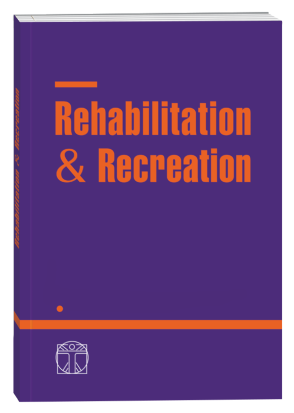MODERN STRATEGIES FOR RESTORATION OF DAILY ACTIVITY IN RHEUMATOID ARTHRITIS
DOI:
https://doi.org/10.32782/2522-1795.2023.17.3Keywords:
comprehensive rehabilitation, rheumatoid arthritis, functional activity, physical component of health, quality of life.Abstract
The article reveals the role and place of rehabilitation tools in restoring the daily activity of patients with rheumatoid arthritis. Taking into account the progressive course of rheumatoid arthritis, the high frequency of lesions in people of working age, the early decline in functional abilities, the loss of professional and social skills and the significant disability of patients, we proposed the use of a complex program of physical rehabilitation, which included modern means. The purpose of the paper was to evaluate the effectiveness of the proposed comprehensive rehabilitation program for women with rheumatoid arthritis to restore daily activity. Material and methods. During the study, to determine the effectiveness of the proposed rehabilitation tools, the quality of life of the thematic patients was assessed using the “SF-36 Health Status Survey” questionnaire. The functional state of women was studied according to indicators of: the physical component of health – physical functioning, role functioning, pain intensity, general health; mental component of health – life activity, social functioning, emotional functioning, psychological health. Results. The proposed means of rehabilitation were aimed at reducing the painful course of the disease, improving the functional status of the musculoskeletal system, improving mental health, which made it possible to effectively control the course of the disease and contribute to improving the quality of life. According to the assessment of the degree of pain, the results in women of the control group at the end of the study were 43.4±1.54 points, in the main group the index was significantly lower – 32.5±1.06 points at p<0.05, which shows a difference of 10%. The effectiveness of a comprehensive rehabilitation program with the use of modern approaches – occupational therapy, orthoses and emotionally-oriented coping has a significant impact on the outcome of rehabilitation: it contributes to the restoration of daily activities of women with rheumatoid arthritis due to the improvement of the quality of life against the background of the improvement of the general mental and physical condition and the less painful course of the disease, which is a confirmation of the hypothesis put forward by us at the beginning of the study. Conclusions. The comprehensive rehabilitation program offered by us is effective according to research data, therefore it can be recommended for use by the specified category of patients (rheumatoid arthritis patients) in the early stages of the disease.
References
Гонт А.А., Зарудна О.І. Ревматоїдний артрит – історія, сучасні погляди, тактика, результат. Медсестринство. 2020. 4:30–36.
Григус І.М., Ногас А.О. Комплексний аналіз больового синдрому у пацієнтів з ревматоїдним артритом. Медичні перспективи.
28(1):148–152. DOI: https://doi.org/10.26641/2307-0404.2023.1.276049.
Кононенко Н.М., Чікіткіна В.В. Основні методи фізичної реабілітації хворих на ревматоїдний артрит. Український журнал медицини, біології та спорту. 2022, 4(38):19–24. DOI: 10.26693/jmbs07.04.019.
Коритко З.І., Поник Р.М., Купріненко О.В. Вплив засобів фізичної реабілітації на якість життя хворих при ревматоїдному артриті. Експериментальна та клінічна фізіологія і біохімія. 2019. 4(88):45–52.
Кривенко В.І., Федорова О.П., Непрядкіна І.В. та ін. Основні ревматичні захворювання в практиці лікаря загальної практики –
сімейної медицини : навчальний посібник для лікарів, лікарів-інтернів за фахом «Загальна практика-сімейна медицина» та «Внутрішні
хвороби». Запоріжжя. 2020. 142.
Курята О.В., Сіренко О.Ю., Лисунець Т.К. Біль у суглобах у хворих ревматологічного профілю: роль контролю тривожно-депресивних розладів. Український ревматологічний журнал. 2017. 2(68):52–57.
Ногас А.О. Оцінка функціональних порушень верхніх кінцівок у хворих на ревматоїдний артрит. Український журнал медицини, біології та спорту. 2023. 8(1):57–58. DOI: 10.26693/jmbs08.01.208.
Ногас А.О. Покращення якості життя хворих на ревматоїдний артрит за допомогою фізичної активності. Rehabilitation & recreation. 2022. 13:48–53. DOI: 10.32782/2522-1795.2022.13.6.
Поник Р.М., Коритко З.І. Захворюваність та особливості реабілітації хворих на ревматоїдний артрит в умовах сьогодення. Здобутки клінічної і експериментальної медицини. 2019. 3:183–187. DOI: 10.11603/1811-2471. 2019. v.i3.10504.
Hassan A.A., Nasr M.H., Mohamed A.L., Kamal A.M., Elmoghazy A.D. Psychological affection in rheumatoid arthritis patients in relation to disease activity. Medicine (Baltimore). 2019. 98(19):e15373. DOI: 10.1097/MD. 0000000000015373.
Grygus I., Nogas A. Main provisions of the concept of physical therapy for patients with rheumatoid arthritis. Journal of Education, Health
and Sport. 2020. 10(3):340–351. DOI: http://dx.doi.org/10.12775/JEHS.2020.10.03.037.
Lins L., Carvalho F.M. SF-36 total score as a single measure of health-related quality of life: Scoping review. SAGE Open Med. 2016. 4:2050312116671725. DOI: 10.1177/2050312116671725.
Cieza A., Causey K., Kamenov K., Hanson S.W., Chatterji S., Vos T. Global estimates of the need for rehabilitation based on the Global Burden of Disease Study 2019: systematic analysis for the Global Burden of Disease Study. Lancet. 2020. 396(10267):2006–2017. DOI: 10.1016/S0140-6736(20)32340-0.
Pozmogova N., Bogdanovska N., Kalonova I., Boichenko C., Bessarabova O. Effect of occupational therapy intervention in a comprehensive rehabilitation program on patients with early rheumatoid arthritis. Journal of Physical Education and Sport. 2021.10:3024–3029. DOI: 10.7752/jpes. 2021. s5402.
Downloads
Published
How to Cite
Issue
Section
License

This work is licensed under a Creative Commons Attribution-NonCommercial-NoDerivatives 4.0 International License.












